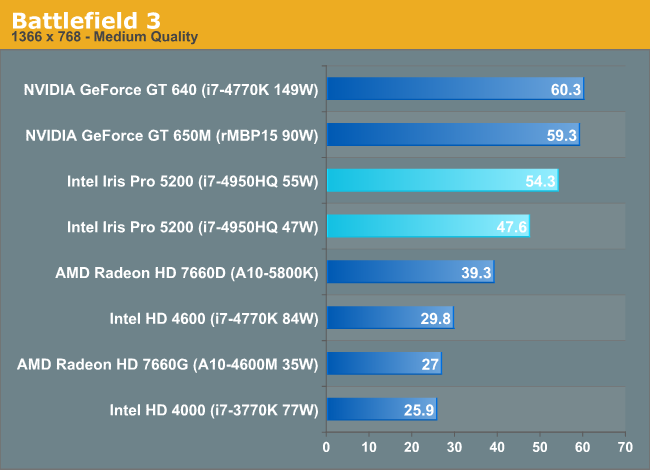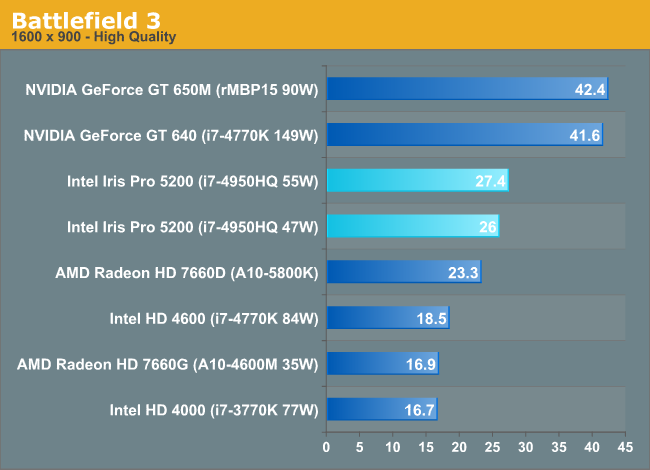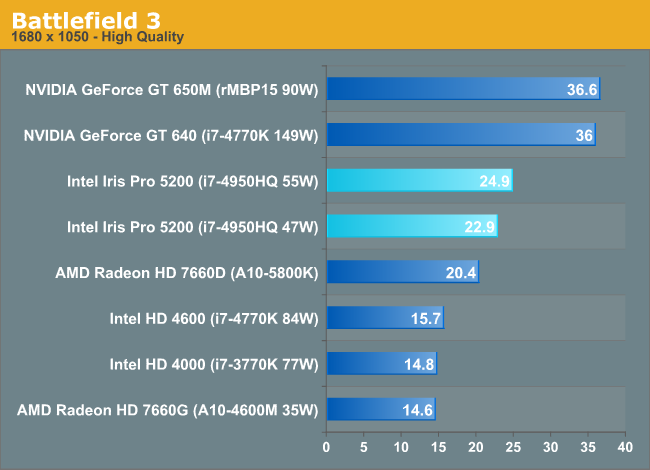Intel Iris Pro 5200 Graphics Review: Core i7-4950HQ Tested
by Anand Lal Shimpi on June 1, 2013 10:01 AM ESTBattlefield 3
Our multiplayer action game benchmark of choice is Battlefield 3, DICE’s 2011 multiplayer military shooter. Its ability to pose a significant challenge to GPUs has been dulled some by time and drivers at the high-end, but it’s still a challenge for more entry-level GPUs such as the iGPUs found on Intel and AMD's latest parts. Our goal here is to crack 60fps in our benchmark, as our rule of thumb based on experience is that multiplayer framerates in intense firefights will bottom out at roughly half our benchmark average, so hitting medium-high framerates here is not necessarily high enough.

The move to 55W brings Iris Pro much closer to the GT 650M, with NVIDIA's advantage falling to less than 10%. At 47W, Iris Pro isn't able to remain at max turbo for as long. The soft configurable TDP is responsible for nearly a 15% increase in performance here.
Iris Pro continues to put all other integrated graphics solutions to shame. The 55W 5200 is over 2x the speed of the desktop HD 4000 and the same for the mobile Trinity. There's even a healthy gap between it and desktop Trinity/Haswell.

Ramp up resolution and quality settings and Iris Pro once again looks far less like a discrete GPU. NVIDIA holds over a 50% advantage here. Once again I don't believe this is memory bandwidth related, Crystalwell appears to be doing its job. Instead it looks like fundamental GPU architecture issue.

The gap narrows slightly with an increase in resolution, perhaps indicating that as the limits shift to memory bandwidth Crystalwell is able to win some ground. Overall, there's just an appreciable advantage to NVIDIA's architecture here.
The iGPU comparison continues to be an across the board win for Intel. It's amazing what can happen when you actually dedicate transistors to graphics.










177 Comments
View All Comments
HisDivineOrder - Saturday, June 1, 2013 - link
I see Razer making an Edge tablet with an Iris-based chip. In fact, it seems built for that idea more than anything else. That or a NUC HTPC run at 720p with no AA ever. You've got superior performance to any console out there right now and it's in a size smaller than an AppleTV.So yeah, the next Razer Edge should include this as an optional way to lower the cost of the whole system. I also think the next Surface Pro should use this. So high end x86-based laptops with Windows 8 Pro.
And NUC/BRIX systems that are so small they don't have room for discrete GPU's.
I imagine some thinner than makes sense ultrathins could also use this to great effect.
All that said, most systems people will be able to afford and use on a regular basis won't be using this chip. I think that's sad, but it's the way it will be until Intel stops trying to use Iris as a bonus for the high end users instead of trying to put discrete GPU's out of business by putting these on every chip they make so people start seeing it CAN do a decent job on its own within its specific limitations.
Right now, no one's going to see that, except those few fringe cases. Strictly speaking, while it might not have matched the 650m (or its successor), it did a decent job with the 640m and that's a lot better than any other IGP by Intel.
Spunjji - Tuesday, June 4, 2013 - link
You confused me here on these points:1) The NUC uses a 17W TDP chip and overheats. We're not going to have Iris in that form factor yet.
2) It would increase the cost of the Edge, not lower it. Same TDP problem too.
Otherwise I agree, this really needs to roll down lower in the food chain to have a serious impact. Hopefully they'll do that with Broadwell used by the GPU when the die area effectively becomes free thanks to the process switch.
whyso - Saturday, June 1, 2013 - link
So intel was right. Iris Pro pretty much matches a 650m at playable settings (30 fps +). Note that anandtech is being full of BullS**t here and comparing it to an OVERCLOCKED 650m from apple. Lets see, when intel made that 'equal to a 650m' claim it was talking about a standard 650m not an overclocked 650m running at 900/2500 (GDDR5) vs the normal 835/1000 (GDDR5 + boost at full, no boost = 735 mhz core). If you look at a standard clocked GDDR3 variant iris pro 5200 and the 650m are pretty much very similar (depending on the games) within around 10%. New Intel drivers should further shorten the gap (given that intel is quite good in compute).JarredWalton - Sunday, June 2, 2013 - link
http://www.anandtech.com/bench/Product/814For the games I tested, the rMBP15 isnt' that much faster in many titles. Iris isn't quite able to match GT 650M, but it's pretty close all things considered.
Spunjji - Tuesday, June 4, 2013 - link
I will believe this about new Intel drivers when I see them. I seriously, genuinely hope they surprise me, though.dbcoopernz - Saturday, June 1, 2013 - link
Are you going to test this system with madVR?Ryan Smith - Sunday, June 2, 2013 - link
We have Ganesh working to answer that question right now.dbcoopernz - Sunday, June 2, 2013 - link
Cool. :)JDG1980 - Saturday, June 1, 2013 - link
I would have liked to see some madVR tests. It seems to me that the particular architecture of this chip - lots of computing power, somewhat less memory bandwidth - would be very well suited to madVR's better processing options. It's been established that difficult features like Jinc scaling (the best quality) are limited by shader performance, not bandwidth.The price is far steeper than I would have expected, but once it inevitably drops a bit, I could see mini-ITX boards with this become a viable solution for high-end, passively-cooled HTPCs.
By the way, did they ever fix the 23.976 fps error that has been there since Clarkdale?
dbcoopernz - Saturday, June 1, 2013 - link
Missing Remote reports that 23.976 timing is much better.http://www.missingremote.com/review/intel-core-i7-...